
South Carolina has the largest, and only, gold mine at the East Coast, East of the Mississippi. Read in the article about the history of gold mining in South Carolina, about its only active gold mine and other facts and figures about gold mining in SC.
Contents
- Is there Gold in South Carolina?
- Where is Gold in South Carolina?
- What is the History of Gold Mining in South Carolina?
- How much gold has been mined in South Carolina?
- What is the Current State of Gold Mining in South Carolina?
- How Many Gold Reserves are in South Carolina?
- What Companies Mine Gold in South Carolina?
- Where are New Gold Mines Explored or Developed in South Carolina?
- Is it Legal to Mine Gold in South Carolina?
- Where Can I Pan for Gold in South Carolina?
- Is There Gold in Other US States?
Is there Gold in South Carolina?
Yes. South Carolina was the biggest gold mining region in the US before the discovery of gold in California.
However, gold production nowadays is limited to only one open pit gold mine, the Haile Mine.
- South Carolina is one of eleven states that contribute towards the US gold production
- the state produced at this mine 4.27 tonnes of gold in 2021. This is around 2.3% of the US gold output of that year, which was 187 tonnes.
- The US Geological Survey lists nearly 300 sites with gold deposits in South Carolina, most of them closed (for comparison: California has more than 20.000 gold sites).
- Historic gold mining sites are in Chesterfield, Lancaster and McCormick County.
- There are several gold exploration projects in the state that might lead to mining operations.
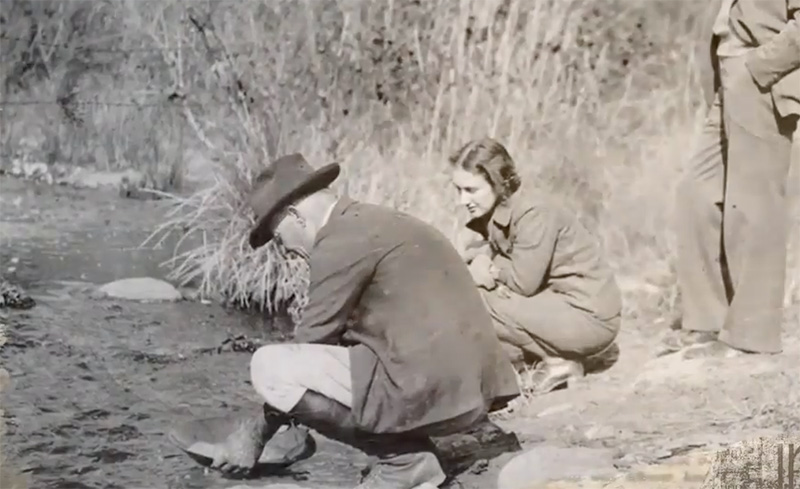
Key Takeaways:
| Fact | Explanation |
|---|---|
| Remember | Biggest gold producing state before the California gold discovery, now only one gold mine left |
| Gold Deposits | Yes |
| Discovery Year | Around 1827 |
| Discoverer | Benjamin Haile, according to legend |
| Mining Industry | Still active |
| Major Gold Locations | At the Carolina Slate Belt |
| Major Active Gold Mines | One mining operation left: the Haile gold and silver mine |
| Mining Companies | OceanaGold Corp. |
| Panning Locations | Rivers of the Black Hills: Rapid Creek, Castle Creek, and Spearfish Creek |
The following map of South Carolina shows the location of the first gold discovery, the Carolina slate belt and the location of the only gold mine left in the state.
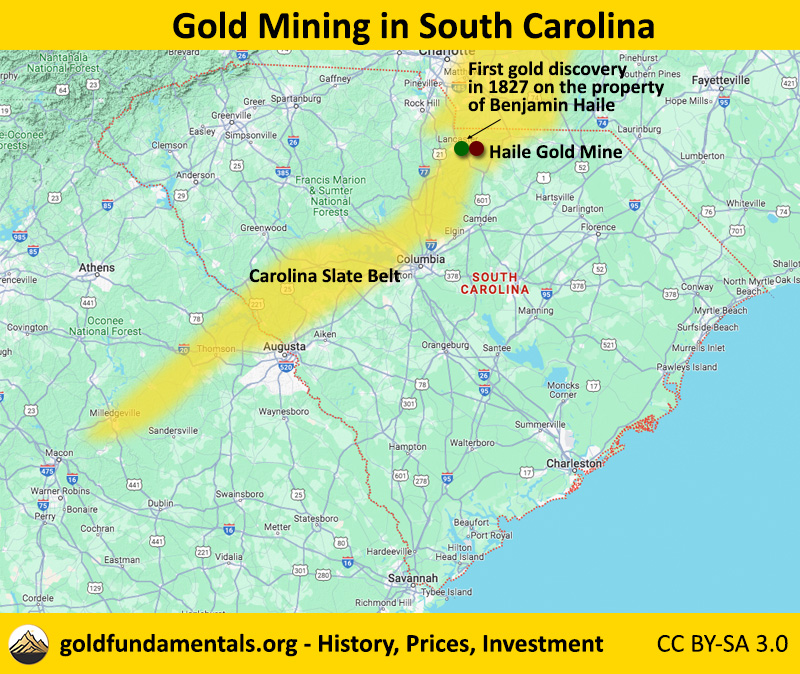
Where is Gold in South Carolina?
The state’s gold deposits are generally concentrated in Carolina Slate Belt, a geologic zone, which runs from Virginia to eastern Alabama. In detail:
- York County: Famous for the Carolina Slate Belt, which is a region rich in minerals, including gold. The town of Smyrna has several areas where gold has been found.
- Lancaster County: Another part of the Carolina Slate Belt, Lancaster County has a history of gold mining, with several active and abandoned mines.
- Chesterfield County: The Haile Gold Mine, located in Chesterfield County, is one of the largest gold mines in the eastern United States.
- Abbeville County: Known for placer mining, which involves extracting gold from river sediments. Streams and rivers in this area have been popular among prospectors.
- Edgefield County: Although less known for gold, there have been discoveries in the county, mostly in the form of small nuggets and flakes.
- Greenville County: This area has a history of small-scale gold mining, with several creeks and rivers that have been panned for gold.
- McCormick County: Part of the historic gold-producing region, with several old mines and prospects.
Source: USGS
What is the History of Gold Mining in South Carolina?
Who discovered gold in South Carolina?
Gold was first discovered in South Carolina in 1827 by Benjamin Haile in the area of Little Meadow Creek in Lancaster County. The discovery led to the establishment of the Haile Gold Mine, one of the oldest gold mines in the United States. This discovery predated the famous California Gold Rush by two decades and was significant in the history of gold mining in the United States.
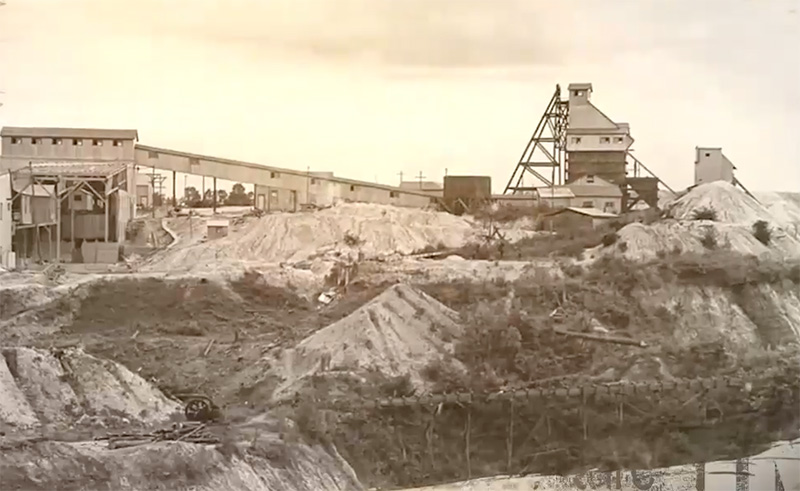
Was there a gold rush in South Carolina?
Yes, there was a gold rush in South Carolina, although it was not as widely known or as extensive as the later California Gold Rush. The South Carolina gold rush began after the first gold discovery in the state in 1827 at the Haile Gold Mine in Lancaster County. Following the discovery at the Haile Gold Mine, gold mining activity in the state increased, leading to the establishment of numerous mines. The region saw a surge in prospecting and mining, with individuals and companies seeking to capitalize on the gold resources.
The South Carolina gold rush was primarily a regional phenomenon, attracting less national attention and fewer prospectors from outside the region. Nonetheless, it was an important part of the early history of gold mining in the United States.
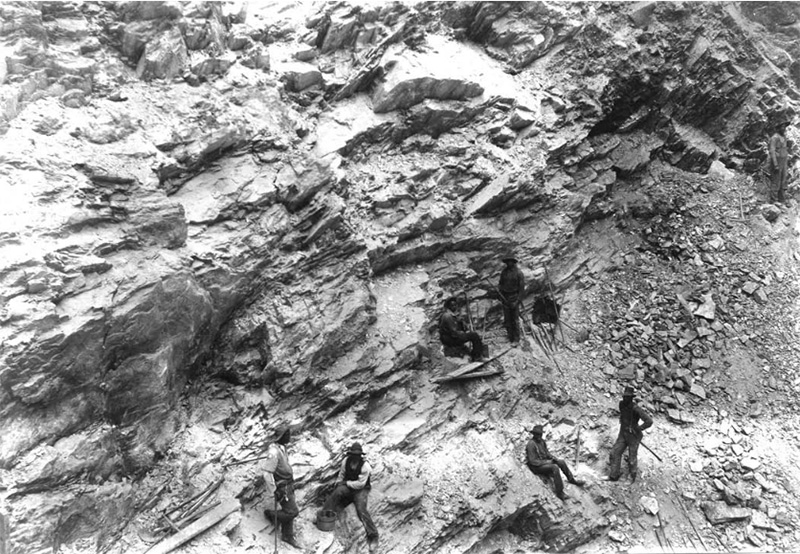
Industrial mining
The gold mining industry in South Carolina was smaller in scale compared to the later California Gold Rush but nonetheless important for the regional economy. It led to the development of mining towns and supported local economies.
The gold mining industry in South Carolina began to decline by the mid-19th century, partly due to the depletion of surface deposits and the difficulty of mining deeper ore. The onset of the Civil War further impacted the industry, as resources were redirected to the war effort, and many mines were abandoned or destroyed.
There was a brief resurgence in gold mining during the early 20th century, driven by technological advancements in mining and processing. However, this resurgence was relatively short-lived, and by the mid-20th century, most of the mining activity had ceased.
The following illustration shows major historic gold mines in South Carolina.

In Detail:
- Haile Gold Mine: near Kershaw, in operation since 1829 (with several closings)
- Brewer Gold Mine: near Mount Croghan, in operation from 1828 to 1995
- Ridgeway Gold Mine: near Ridgeway, open pit mine, in operation from 1988 to 1999
- Barite Hill Gold Mine: near McCormick, in operation from 1990 to 1994
- Howie Gold Mine: on the map below, but located in North Carolina, near Waxhaw, in operation from 1841 to 1935.
Sources: scencyclopedia, the diggings, OceanaGold
How much gold has been mined in South Carolina?
Total gold production in South Carolina was 318,801 ounces until 1959.
There is no public record of total gold mining figures until today.
Source: USGS
What is the Current State of Gold Mining in South Carolina?
The current state of gold mining in South Carolina is characterized by only one active gold mine in the state, the Haile gold mine.
For a chart of the annual gold output in South Carolina from 2017 till 2021, see chart below:
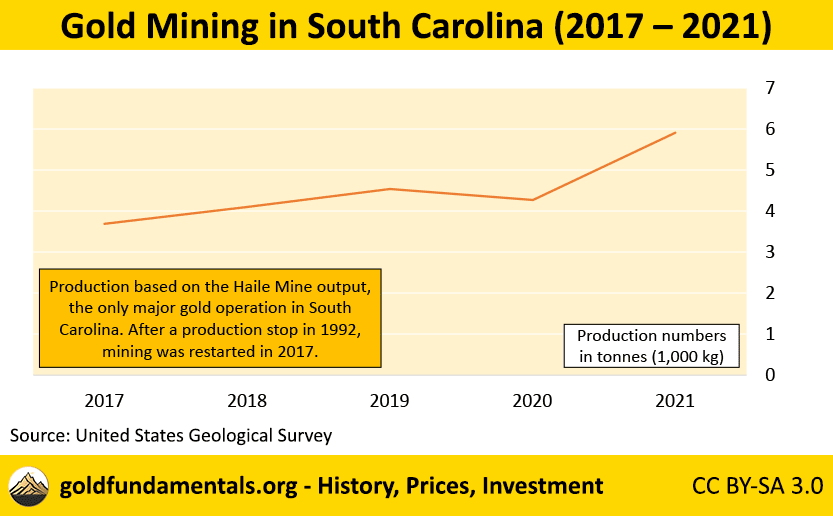
What is the major gold mine in South Carolina?
The US Geological Survey Minerals Yearbook lists in its most recent overview of 44 leading gold operations in the US and only one gold producing operations in the state of South Carolina: the Haile Mine (owned by OceanaGold Corp.).
The US state leading the ranking is Nevada with 27 operations, followed by Alaska with four operations.
List of the gold operation in South Carolina:
| US Rank | Operation | County and State | Majority Owner (2024) | Qty 2020 |
Qty 2021 |
|---|---|---|---|---|---|
| 12 | Haile Mine | Lancester, SC | OceanaGold Corp. | 4.270 | 5.910 |
Explanation:
Rank: a comparison of the output of US mines. Therefore, Haile Mine, as the only South Carolina mine, is ranked number 12 of all US gold mines. Eight of the ten biggest mines are in Nevada and one in Alaska and one in Colorado.
Quantity: in kilogram; there are approx. 32 fine ounces in one kilogram
Facts about the Haile Mine
The Haile gold and silver mine consists of a series of open pits.
- It is located near the town of Kershaw, Lancester county, close to the border to North Carolina.
- The mine has been in operation since 2017, but its history goes back nearly 200 years.
- An underground mine is currently under development.
- Gold resources are projected to last until 2034.
- The owner, OceanaGold is an Australian Company.
History of the Haile mine:
- The mine was built after the discovery of the first gold in South Carolina, in 1827.
- It produced gold till 1942, after which it was closed as a non-essential operation during the war.
- Reopening as a gold mine occurred in the 1980s, closure again in 1992.
- Since 2017 mining by its new owner, OceanaGold Corp.
Video about the Haile mine:
How Many Gold Reserves are in South Carolina?
Gold reserves based on the estimates of the Haile Mine are in total 6,13 million ounces (as of 2023).
In detail:
- 45 millon ounces of proven and probable reserves
- 98 million ounces of measured and indicated resources
- 7 million ounces of inferred resources
Source: company website
What Companies Mine Gold in South Carolina?
OceanaGold Corp, is a mining company that is listed on the Toronto stock exchange. It is based in Vancouver (Canada) and Brisbane (Australia). The company was founded in New Zealand and has 3,700 employees.
Check out the company video:
The company has four operations
In detail:
- Haile Gold Mine in South Carolina
- Didipio Gold Mine in the Philippines
- Macraes and Waihi Gold Mines in New Zealand
Sources: company website
Where are New Gold Mines Explored or Developed in South Carolina?
There are several gold exploration projects in South Carolina:
Horseshoe underground expansion of the Haile Mine
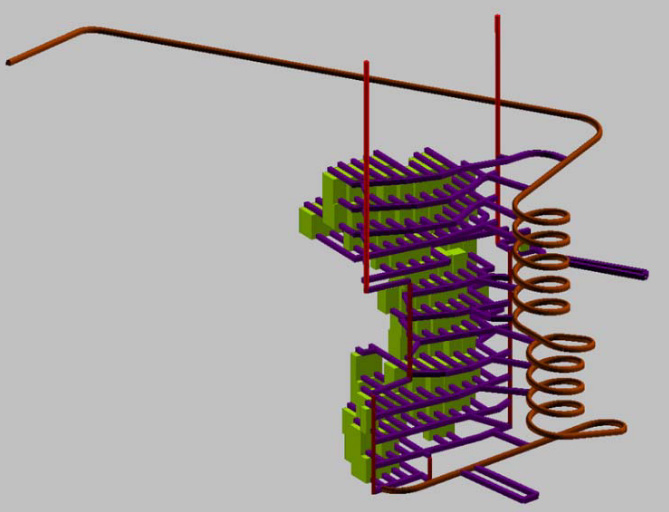
- Extension of mine life from 14 to 16 years
- Development of underground mining expected to cost USD 110 million and generate 200 direct jobs on site
- Completion of all federal permits
- First ore mined in Oktober 2023
- Total ore production expected to be 90 000 to the mine plan in 2023
- Ramp up in 2024
Brewer Gold & Copper Project
- Owned by Carolina Rush Corp.
- Located in Chesterfield county, in the Carolina Slate Belt
- Project is the former Brewer mine with gold production from 1985 to 1993
- Currently in exploration phase
Video with company update on the Brewer Gold & Copper Project:
Gold Project at Landrum Property
- End of 2023 acquisition of Landum gold property by Advanced Gold Exploration Inc.
- The property covers two known gold occurrences: the Landrum and Faulkner mountain
- Gold mining in the past, from the 1850s to the 1930s
Sources: Carolina Rush, mining, miningweekly, mtech, newsfile
Is it Legal to Mine Gold in South Carolina?
In South Carolina, it is legal to mine gold under certain regulations.
- The South Carolina Department of Health and Environmental Control is responsible for administering the process and issuance of mining permits, as well as the review and approval of reclamation plans.
- Individual mine operating permits are required for mining operations of any size, and general mine operating permits are limited to areas less than five acres.
- The removal of ores from the ground for sale or for use in a business is defined as mining, and the state issues permits for various types of surface mining, including open pit, strip mines, and sand dredging from river bottoms.
- In terms of specific activities, only panning is allowed in Sumter National Forest, and no mechanized equipment is permitted.
- For other activities such as dredging in the main rivers of South Carolina, permits and regulations apply, and it is advisable to contact the South Carolina Department of Health and Environmental, Control for guidance and to obtain the necessary permits.
Sources: goldprospectors, DHEC, South Carolina Legislature
Where Can I Pan for Gold in South Carolina?
Check out the video about gold prospecting in South Carolina:
In South Carolina, there are several locations where you can pan for gold:
- Haile Gold Mine: Discovered in 1827, it’s one of the state’s most profitable gold mines, still active under the OceanaGold company.
- Broad River in York County: This river is known for gold-bearing streams, with the York County stretch being particularly productive. Prospectors can also try King’s Creek, Wolf Creek, and Bullock’s Creek in this area.
- Cherokee County: Famous for its Love Springs Mine, the county offers numerous opportunities for recreational prospectors, with most rivers and streams containing small quantities of gold.
- Saluda County: Gold is found in almost all rivers here, with the Little Saluda River and its tributaries being particularly notable.
- Chesterfield County: Nugget Creek, aptly named for its past gold finds, is a key location for prospectors, although mostly placer gold is found now.
- Heritage Gold Mine Park in McCormick: This park features an 1850s gold mine and offers opportunities for visitors to pan for gold, with guaranteed gold pieces in purchased ore bags. The park is open seasonally from May to October.
- Carolina Slate Belt Region: Extending across South Carolina, this region includes Lancaster, York, Cherokee, Chesterfield, Saluda, and Edgefield Counties, all known for their potential in gold prospecting.
Sources: gold fever prospecting, scencyclopedia
Is There Gold in Other US States?
Check out gold production in neighboring states of South Carolina: North Carolina and Georgia.
According to the U.S. Geological Survey (USGC), there are 11 states that mine gold and contribute towards the gold mining statistic: Nevada is responsible for the majority of gold output, around 72%, followed by Alaska (13%). 9 other contribute in sum to the remaining 15% of gold production: Arizona, California, Colorado, Idaho, Michigan, New Mexico, South Carolina, South Dakota, and Utah.
